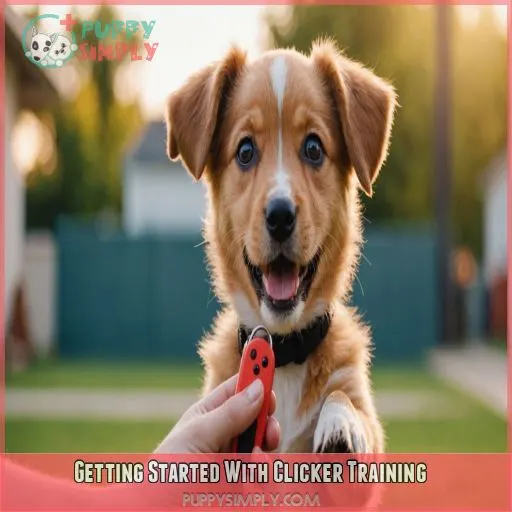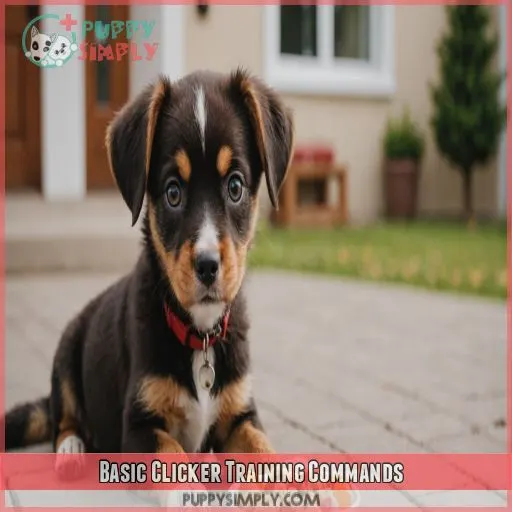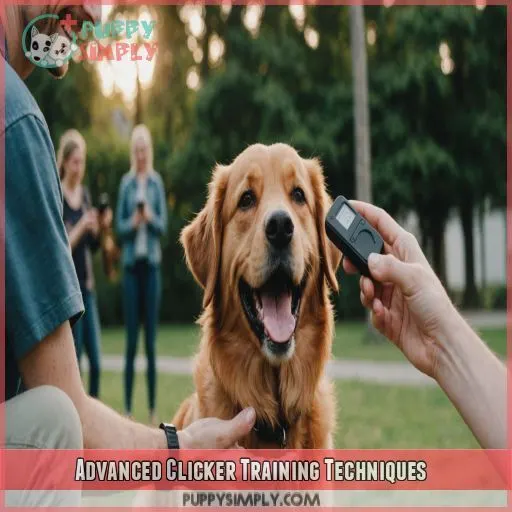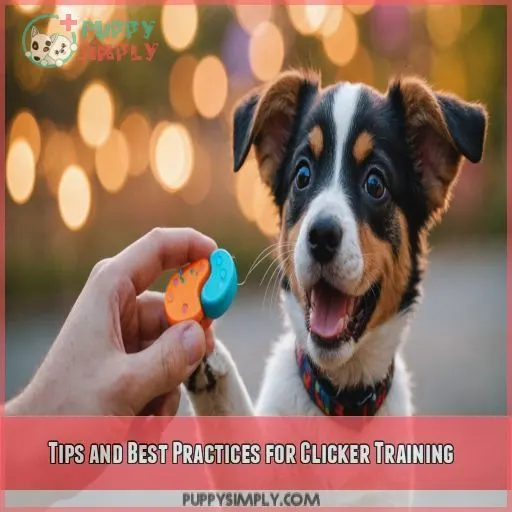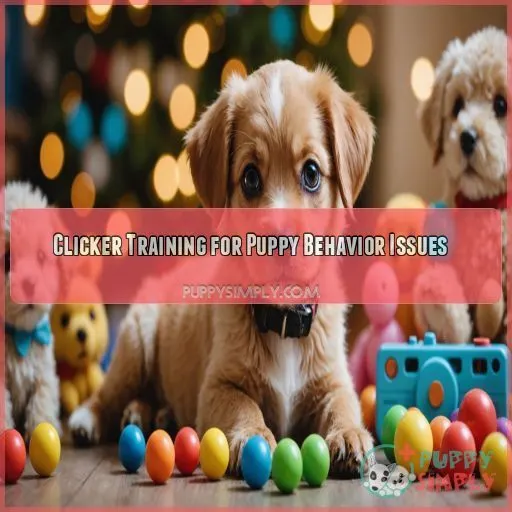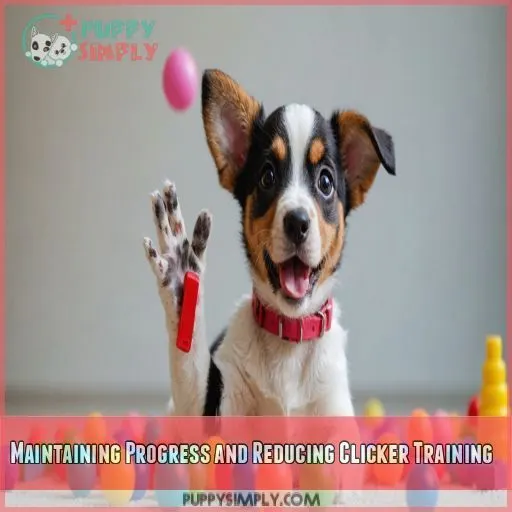This site is supported by our readers. We may earn a commission, at no cost to you, if you purchase through links.

With puppy clicker training techniques, you can teach your furry friend to sit, stay, and even do tricks in no time.
Clicker training is a fun, fast, and scientifically-proven method that uses positive reinforcement to get results.
By associating a click with a reward, you’ll be amazed at how quickly your puppy picks up new behaviors.
With consistency and timing, you’ll be well on your way to raising a well-behaved pup**.
Ready to get started and learn the magic of clicker training?
Let’s get into the basics and beyond!
Table Of Contents
- Key Takeaways
- Getting Started With Clicker Training
- Basic Clicker Training Commands
- Advanced Clicker Training Techniques
- Tips and Best Practices for Clicker Training
- Clicker Training for Puppy Behavior Issues
- Maintaining Progress and Reducing Clicker Training
- Frequently Asked Questions (FAQs)
- How do I train my puppy with a clicker?
- Is a clicker good for training a puppy?
- What age can you start clicker training a puppy?
- How do you stop a puppy from biting you with a clicker?
- Can clicker training be used on older dogs too effectively?
- Does clicker training work for dogs with hearing impairments?
- Can multiple people use clicker training on one puppy simultaneously?
- How long does a typical clicker training session last daily?
- Is clicker training suitable for puppies with food allergies or sensitivities?
- Conclusion
Key Takeaways
- Clicker training is a fun, fast, and scientifically-backed method that uses Positive Reinforcement to train your puppy.
- The clicker acts as a clear marker of good behavior, helping your pup understand exactly what they did right.
- This technique promotes a strong bond between you and your puppy, boosts their confidence, and makes learning a breeze.
- You can use clicker training to teach basic obedience commands, tricks, and even address behavior issues like biting or anxiety.
Getting Started With Clicker Training
You’re about to discover the power of clicker training, a fun and effective way to teach your puppy new behaviors and strengthen your bond. As you get started with clicker training, you’ll learn how to use this simple tool to mark good behavior, reward your puppy, and set them up for a lifetime of good habits and happy learning.
What is Clicker Training?
You’re about to discover the power of clicker training! This positive reinforcement method uses a clicker to mark the exact moment your puppy performs a desired behavior, followed by a reward. It’s a game-changer for fast, fun, and effective training.
- Clicker training is based on the science of animal learning
- It’s a low-cost, portable, and versatile training tool
- Clicker training promotes a strong bond between you and your puppy
- It’s suitable for puppies of all ages and breeds
How Does Clicker Training Work?
you use a clicker to mark the exact moment your puppy performs a desired behavior, like sitting. The clicker acts as a conditioned reinforcer, associated with a reward, like a treat. This positive reinforcement technique helps your puppy learn fast and fun. Master the clicker timing and reward association for effective training.
Benefits of Clicker Training for Puppies
You’re about to discover the magic of clicker training! It will boost your puppy’s confidence and make learning a breeze. Here are just a few benefits you can expect:
- Faster learning through instant feedback
- Quality bonding time with your pup
- Stronger recall in distracting situations
- Reduced stress for both you and your puppy
- A more rewarding training experience overall
Choosing the Right Clicker for Your Puppy
Choosing the right clicker for your pup is important.
You want something that’s comfy to hold and easy to use.
Consider the clicker sound, size, material, and durability.
Some clickers are louder than others, so test a few to find one that’s not too loud for your pup.
They come in different sizes and materials, from plastic to metal, so pick one that suits your grip and isn’t too bulky.
Basic Clicker Training Commands
Now that you’ve introduced your pup to the clicker, it’s time to start teaching them some basic commands. In this section, we’ll guide you through the process of using clicker training to teach your furry friend essential behaviors like sitting, lying down, and staying.
Step-by-Step Guide to Teaching Sit
Now that your puppy understands the clicker, it’s time to teach them to sit. This basic command is a great starting point for Puppy Clicker Training. Here’s how to do it:
- Hold a treat above their nose and slowly move it upwards, saying "sit."
- As their head follows the treat, their bottom should lower—click as their bum touches the floor.
- Say "yes!" and give them the treat.
- Repeat this a few times daily, and soon they’ll be sitting on command.
Teaching Down and Stay With Clicker Training
Now that your pup’s a pro at sitting, let’s move on to the "down" command.
This one’s a little trickier, but with patience and the right technique, your dog will be dropping like a pro.
Start by luring your pup into the down position with a treat.
As their head follows the treat toward the floor, click the moment their elbows touch the ground.
Using Clicker Training for Basic Obedience Commands
Now you’re ready to tackle some basic obedience commands with your pup. These are essential for any well-behaved pooch and will come in handy in everyday life. Let’s break down teaching the "sit," "stay," and "down" commands with clicker training. It’s all about timing and patience!
- Sit Command: Wait for your pup to sit, then click and treat. Soon, they’ll associate sitting with a reward.
- Stay Command: Ask your pup to stay, then click and treat for obeying. Gradually increase the duration.
- Down Command: Lure your pup into a down position, then click and reward.
Advanced Clicker Training Techniques
Now that you’ve mastered the basics of clicker training, it’s time to level up! In this section, we’ll explore advanced techniques to teach your pup more complex behaviors and tricks.
Shaping Complex Behaviors With Clicker Training
So your pup’s aced the basics, and you’re ready to take things to the next level.
Advanced clicker training techniques, like shaping, are key to teaching complex behaviors.
Shaping breaks a tricky behavior into a shaping sequence of steps, rewarding each tiny success.
It’s like a puzzle, where your pup figures out each piece through trial and error, eventually completing the whole picture.
With patience and practice, your puppy will be performing cool moves in no time!
Using Clicker Training to Teach Tricks and Agility
Now your puppy has mastered the basics, it’s time for some fun!
Clicker training for agility and tricks is an awesome way to challenge your dog and show off their skills.
You can teach your pup to weave, jump, and spin with precision using clicker training for agility courses or impressive tricks.
It’s all about shaping complex tricks by breaking them down into small steps.
Even small dogs can learn big tricks with clicker training!
Advanced Clicker Training for Off-Leash Obedience
Now for the fun part: off-leash obedience!
This advanced clicker training technique gives your pup freedom while ensuring they listen to your every command.
Start with a solid foundation of basic commands, then practice in low-distraction areas before taking it out into the real world.
Focus on distance control and distractions to keep your pup engaged with you, even when they’re off-leash.
It’s all about building that unbreakable bond!
Tips and Best Practices for Clicker Training
You’ve mastered the basics of clicker training, but now it’s time to refine your skills and make sure your pup is on the right track. Consistency and timing are key, so keep your training sessions regular and click that clicker at the perfect moment to shape your puppy’s behavior.
The Importance of Consistency and Timing in Clicker Training
Consistency and timing are key to successful puppy clicker training techniques.
Always follow a click with a reward; it’s a promise of a treat.
Keep the clicker casual, no need to point it like a magic wand.
Timing is everything, click the moment your pup nails it.
Be consistent with rewards, no treat, no cheat!
This clear communication builds trust and understanding.
Training classes can help perfect your timing and consistency, so you and your pup stay in sync.
How to Avoid Common Clicker Training Mistakes
To avoid common clicker training mistakes, focus on clicker timing and reward consistency. Don’t over-click, as this can confuse your pup. Make sure your dog has a strong clicker association by using treats frequently at first, then gradually reducing them. Watch for signs of frustration or boredom, and adjust your approach as needed to keep training sessions fun and engaging.
Using Positive Reinforcement in Clicker Training
Positive reinforcement is the cornerstone of clicker training. It’s all about rewarding good behavior to encourage your pup to repeat it. Here are some tips to maximize its impact:
- Reward-Based Methods: Focus on rewarding the behaviors you want, rather than punishing the ones you don’t. This creates a positive association with learning and builds your pup’s confidence.
- Treat Alternatives: While treats are common rewards, don’t rely on them solely. Use praise, petting, or a favorite toy as alternatives to keep training engaging and prevent overfeeding.
- Shaping Behaviors: Break complex behaviors into smaller steps and reward each success. This builds your puppy’s confidence and understanding.
- Clicker Consistency: Be consistent with clicker timing and always follow a click with a reward. This makes sure your puppy understands the connection between the click and their behavior.
How to Keep Clicker Training Sessions Short and Fun
To keep your pup engaged, mix up playtime training with short sessions. This keeps training fun and effective. Here’s a table with tips to make sure sessions are enjoyable for both you and your furry friend:
| Tip | Explanation |
|---|---|
| Keep It Short | Aim for 10-15 minute sessions. |
| Switch It Up | Alternate between commands to keep things interesting. |
| Play Clicker Games | Try "Guess the Command" or "Simon Says." |
| Positive Reinforcement | Always end on a positive note with a treat or praise. |
| Take Breaks | If your pup seems bored or distracted, take a break and try again later. |
Clicker Training for Puppy Behavior Issues
You’re probably no stranger to the chaos that comes with raising a puppy – from biting and chewing to potty accidents and separation anxiety. Clicker training can be a game-changer in addressing these common behavior issues, helping you raise a well-behaved and well-adjusted pup.
How to Stop Puppy Biting With Clicker Training
Let’s tackle that pesky puppy biting! Clicker training is your friend here. Whenever your pup bites, calmly say "no" and withdraw your hand. Next, offer a toy and click as soon as they bite it instead of you. Reward with treats and praise. Repeat this process to teach bite inhibition and redirect their behavior. Patience is key!
Using Clicker Training to Address Puppy Fear and Anxiety
Clicker training isn’t just for tricks—it’s a powerful tool to help your anxious pup, too. Here’s how:
- Anxiety-Reducing Games: Play games like hide-and-seek or scavenger hunts to build confidence. Click and treat when they find you or an item.
- Clicker for Socialization: New experiences can be scary. Use the clicker to positively expose your pup to different people, places, and things.
- Food for Comfort: During stressful times, use their favorite treats. Clicking and treating will help them associate scary situations with something positive.
Clicker Training for Housebreaking and Potty Training
Clicker training is a game-changer for potty training your pup. It’s all about positive reinforcement, so no scolding for accidents! Create a potty schedule and stick to it. Take your puppy out at regular intervals and click when they eliminate outdoors. Here’s a handy table with some do’s and don’ts:
| Do | Don’t |
|---|---|
| Stick to a schedule | Wait for accidents |
| Use the clicker for outdoor cues | Scolding for indoor accidents |
| Reward with treats | Overload with treats |
| Be patient | Expect instant perfection |
Maintaining Progress and Reducing Clicker Training
You’ve nailed the basics of clicker training your pup, but how do you maintain their good behavior and reduce your reliance on the clicker? This section will teach you how to phase out clicker rewards gradually while keeping your pup’s progress on track.
How to Gradually Phase Out Clicker Training Rewards
As your puppy becomes a clicker training pro, you can start phasing out the treats. It’s all about balance and strategy:
- Reward Fading: Gradually reduce the number of treats after each successful command. Start by rewarding every third or fifth correct behavior, then slowly increase the intervals.
- Treat Frequency: Instead of giving a treat every time, use random intervals to keep your pup guessing and engaged.
- Clicker Only: Once your pup has mastered a behavior, try using the clicker as the sole reward. The click becomes their treat, and they’ll still feel proud!
Maintaining Good Behavior With Occasional Clicker Training
Even after phasing out clicker training rewards, it’s a good idea to keep your pup on their toes with the occasional clicker training session.
This reinforces good behavior and keeps their skills sharp.
You can also use clicker training to address any new, unwanted behaviors that may crop up as your pup matures.
It’s a handy tool for lifelong learning and keeping those obedience commands on lock.
Frequently Asked Questions (FAQs)
How do I train my puppy with a clicker?
Get started with clicker training by associating the click with a treat, then use it to mark desired behaviors like sitting or staying. Be patient, consistent, and reward good behavior – your puppy will catch on in no time!
Is a clicker good for training a puppy?
You’re wondering if a clicker is good for training a puppy? Absolutely! A clicker helps you pinpoint the exact moment your puppy does something right, making training faster, fun, and super effective.
What age can you start clicker training a puppy?
You can start clicker training your puppy as early as 8-10 weeks old. At this age, they’re curious and excited to learn. Keep sessions short and fun, and remember to reward good behavior with treats and praise.
How do you stop a puppy from biting you with a clicker?
Imagine those tiny puppy teeth sinking into your skin – ouch! To stop the biting, click and reward calm behavior, like sitting or licking. When biting starts, freeze, and withdraw attention until calmness returns.
Can clicker training be used on older dogs too effectively?
You can totally use clicker training on older dogs too! It’s a great way to teach new tricks or refine existing behaviors, and it’s never too late to start. Just be patient and adjust your approach to suit their needs.
Does clicker training work for dogs with hearing impairments?
You’re wondering if clicker training works for dogs with hearing impairments? The answer is yes! Since clicker training relies on association with a visual cue, like a hand signal, and a reward, it can be effective for dogs with hearing impairments.
Can multiple people use clicker training on one puppy simultaneously?
You can have multiple people use clicker training on one puppy, but it’s really important to use the same commands, hand signals, and rewards to avoid confusing your puppy – consistency is key to successful clicker training.
How long does a typical clicker training session last daily?
How long can you realistically commit to training each day? Aim for 10-15 minute clicker training sessions, several times a day, to keep your puppy engaged and focused without overwhelming them (or you!).
Is clicker training suitable for puppies with food allergies or sensitivities?
You can still use clicker training with puppies who’ve food allergies or sensitivities – just swap treats with allergy-friendly alternatives, like green beans or carrots, and consult with your vet for personalized advice.
Conclusion
Chaos one day, calm the next – the magic of puppy clicker training techniques can transform your furry friend in no time!
With consistency, patience, and positive reinforcement, you’ve got the winning formula for raising a well-behaved pup.
As you’ve learned, clicker training is more than just a tool – it’s a fun, fast, and scientifically proven method to help your puppy reach their full potential.

